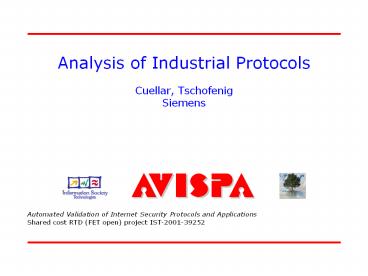Analysis%20of%20Industrial%20Protocols%20Cuellar,%20Tschofenig%20Siemens - PowerPoint PPT Presentation
Title:
Analysis%20of%20Industrial%20Protocols%20Cuellar,%20Tschofenig%20Siemens
Description:
Safety Temporal Property. In some cases they reduce to. classical authentication secrecy ... Safety Temporal Property. Session Formation. Consistent View ... – PowerPoint PPT presentation
Number of Views:70
Avg rating:3.0/5.0
Title: Analysis%20of%20Industrial%20Protocols%20Cuellar,%20Tschofenig%20Siemens
1
Analysis of Industrial ProtocolsCuellar,
TschofenigSiemens
2
Context Standardisation Committees for
Internet Protocols
W3C
OMA
html
xml
IETF
HTTP
TCP
UDP
IP
3GPP
IEEE
802.11
They are all doing a good job, but ....
3
They need help
- Even using perfect cryptographic algorithms
- they may be used in insecure ways...
- Errors in security are very costly
- Updates are costing hundreds of millions, e.g.
WLAN/WEP - Other protocols are delayed by years, e.g.
Mobile-IP, Geopriv - Eroding confidence in Internet Security and
e-commerce - Security protocol design is very difficult, needs
- abundance of caution,
- experienced cryptographers and security protocol
designers - and fast, scalable, and usable protocol analysis
tools! - This is where AVISPA is making the difference
4
Project Objectives
- Develop a rich specification language for
formalising industrial strength security
protocols and their properties. - Advance state-of-the-art analysis techniques to
scale up to this complexity. - Develop the AVISPA tool based on these
techniques. - Tune and assess the AVISPA tool on a large
collection of practically relevant, industrial
protocols. - Migrate this technology to developers and
standardisation organisations.
5
Coverage of the AVISPA Protocol Candidates
- The IETF, IEEE, 3GPP, OMA etc. need tools that
cover a wide range of protocols - and security properties
- 11 different areas (in 33 groups)
- 5 layers
- 20 security goals (as understood at IETF, 3GPP,
OMA, etc)
6
Areas
- Infrastructure (DHCP, DNS, BGP, stime)
- Network Access (WLAN, Pana)
- Mobility (Mobile IP, HIP, Seamoby)
- VoIP, messaging, presence (SIP, ITU-T H530, impp,
simple) - Internet Security (IKE, IKEv2, UMTS-AKA, TLS,
Kerberos, EAP EAP Methoden, OTP, Sacred, ssh,
telnet,...) - Privacy (pseudonym agreement protocols)
- AAA, Identity Management, Single Sign On (Liberty
Alliance) - Security for QoS and NAT/FW signaling, etc.
(NSIS) - Broadcast/Multicast Authentication (TESLA)
- E-Commerce (Payment)
- Perhaps Secure Download, Content protection (DRM)
7
Layers
Application
impp
impp
Middleware
SIP /http
SIP /http
tcp / udp
tcp / udp
Transport Layer
ip
ip
Network Layer
Ethernet
Ethernet
Data Link Layer
Physical Layer
Access Point, Gateway or Host
Host
8
Security Goals
- Authentication Secrecy (unicast multicast)
- Peer Entity , Data Origin, Implicit Destination
Authn, Replay Protection - Key Agreement Properties
- Key authentication (implicit key authentication)
- Key confirmation (Key Proof of Possession)
- Fresh Key Derivation (key freshness)
- Anonymity (aka passive user identity
confidentiality) - Identity Protection against Eavesdroppers
- Non-repudiation
- Proof of Origin
- Proof of Delivery
All of them reduce to classical authentication
secrecy properties
9
Security Goals
- Authentication Secrecy (unicast multicast)
- Authorisation (by a Trusted Third Party)
- Key Agreement Properties
- Perfect Forward Secrecy (PFS)
- Secure capabilities negotiation
- (Resistance against Downgrading and Negotiation
Attacks) - Anonymity
- Identity Protection against Peer
- Non-repudiation
- Proof of Origin
- Proof of Delivery
- Accountability
- Limited DoS Resistance
- Sender Invariance
- Safety Temporal Property
In some cases they reduce to classical
authentication secrecy properties, but other
properties may also be necessary.
10
Security Goals
- Authentication Secrecy (unicast multicast)
- Authorisation (by a Trusted Third Party)
- Key Agreement Properties
- Perfect Forward Secrecy (PFS)
- Secure capabilities negotiation
- (Resistance against Downgrading and Negotiation
Attacks) - Anonymity
- Identity Protection against Peer
- Non-repudiation
- Proof of Origin
- Proof of Delivery
- Accountability
- Limited DoS Resistance
- Sender Invariance
- Safety Temporal Property
- Session Formation
- Consistent View (synchronization)
- Key naming
11
Coverage of established IETF Security
Specifications
AVISPA covers 86 (24 of the 28) of the Security
Protocols listed in RFC 2316,RFC 3631, Auth-mech
(plus very current ones) Total of more than 90
protocols
12
New Problems offer new Challenges
- Internet offers agent many identities
- user, ip, mac, tcp port, ... What is A,
ID_A? - Location of adversaries
- over the air
- safer routes
- Many types of DoS attacks
- flodding, bombing, starving, disrupting
- New types of security goals
- DoS
- key control, perfect forward secrecy, ...
- layered properties
- if attacker ltweakgt then guarantee ltDoS
resilienceconfidentialityintegritygt - if attacker ltstronggt then guarantee ltat least
confidentialityintegritygt
13
Conclusions
- The standardisation organisations need us
- Avoid delays in the standardisation process
- Avoid errors in deployed standards
- Help to restore the trust on e-commerce, privacy
- Automatic tools are needed
- Fast evaluation of alternatives
- Our candidates cover
- all 5 IP layers
- most (11) IP Areas
- almost all security goals
- 86 of the recommended IETF security Protocols
- further information on http//www.tschofenig.com/a
vispa/ - We still have many challenges ahead of us!
14
Verification has been used already in
Standardization
- H.530































